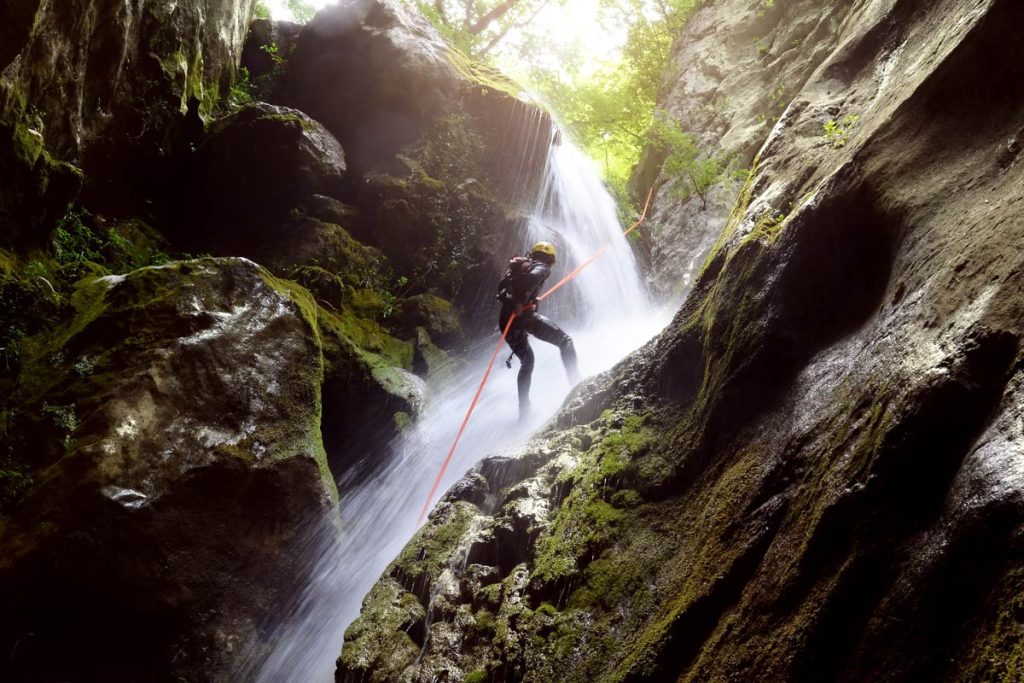A number of canyon harnesses of unrelated makes and models were reported to have broken in the period between July 2017 and December 2018. The incidents happened in mainland France and in La Réunion, fortunately without any serious injuries. In response to these failures, a UIAA Safety Commission working group including manufacturers, alpine clubs and testing laboratories carried out extensive studies on the long-term effects of canyoning harness performance in the aggressive environment of canyons. Initial details related to this research were provided in July 2023. This latest article details the testing process, the results, conclusion and advice for canyoners.
What was tested
The aims of the study were to test:
- On one hand, in accordance with EN 12277/UIAA 105, the resistance of several worn harnesses’ attachment points and belts. The resistance of some showed a severe drop, down to 10% of the standard value in a period of three to four years. Such a loss of resistance did not occur for “dry” activities, i.e. climbing or alpinism.
- On the other hand, the loss of resistance as the webbing, used to manufacture harnesses, ages either in UV aging chambers or in the field: the harnesses are currently made in polyamide, polyester and dyneema.
The results of these tests give a trend towards ageing of fibres and are summarised in the table below:
| Residual Resistance | |||
| Exposure Time (days) | Polyamide | Polyester | Dyneema |
| 0 | 100% | 100% | 100% |
| 100 | 90% | 90% | 80% |
| 200 | 70% | 80% | 60% |
| 400 | 45% | 75% | 40% |
Table 1: Residual strength of the different types of webbing used for manufacturing canyoning harnesses according to exposure time
Lifespan
A day is assumed to be equivalent to seven hours of use.
Main Conclusions
– 200 days would then impact the resistance of the webbings made in polyamide, polyester and dyneema of 70%, 80% and 60% respectively.
– and 400 days would impact the resistance of the webbings made in polyamide, polyester and dyneema of 45%, 75% and 40% respectively.
Polyester is therefore less sensitive to UV weathering than polyamide and dyneema The tests performed show that there is no correlation between textile discoloration and their loss of strength. For the user it is not therefore possible to assess the degree of product exposure to UV light simply by a visual examination based on its discoloration. Straps that are extremely weakened by severe exposure to UV light may not show any discolouring.
On a finished product like a canyon harness, the combination of UV weathering with other weathering factors like abrasion, repeated flexing at the tie-in point, etc. may explain the failures observed on the harnesses between 2017 and 2018. The components of these harnesses that failed were made up of polyamide, a material severely impacted by UV weathering.
Consequently, to ensure the safety of canyoners, it is strongly advised that the following recommendations need to be adhered to:
- Strictly follow the manufacturer’s instructions of use.
- Strictly follow the recommendations of the manufacturers regarding the frequency of checks and the criteria for disposal (look at the instructions for use given with each harness, or on the manufacturer’s websites).
- Do NOT dry the harness by exposing it to high temperatures. Use a dehumidifier, or slowly dry equipment in a ventilated room, protected from light. Never store, or dry a canyoning harness on a car roof, behind glass, etc.
- Respect the manufacturers’ recommendations regarding the abrasion of equipment.
- When used intensively, keep in mind the details in Table 1 (to not exceed a too large number of use in terms of total days).
- DISCARD a harness with notched or frayed straps, or a rusty/deformed tightening loop (see examples of two harnesses below).
